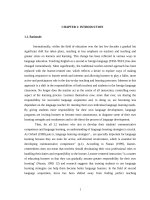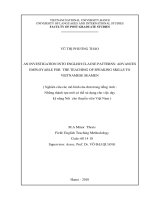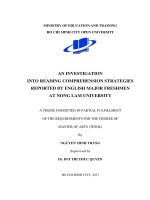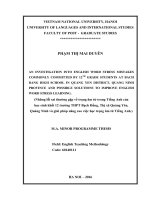An investigation into english intonation patterns performed by students in grade 9 at trung vuong lower secondary school in danang city
Bạn đang xem bản rút gọn của tài liệu. Xem và tải ngay bản đầy đủ của tài liệu tại đây (1.68 MB, 26 trang )
THE UNIVERSITY OF DANANG
UNIVERSITY OF FOREIGN LANGUAGE STUDIES
Đ
PHẠM LÂM NAM PHƯƠNG
ại
họ
AN INVESTIGATION INTO ENGLISH INTONATION
c
PATTERNS PERFORMED BY STUDENTS IN GRADE 9
Đ
AT TRUNG VUONG LOWER SECONDARY SCHOOL
à
IN DANANG CITY
g
ẵn
N
Major: ENGLISH LANGUAGE TEACHING
Code: 8140111
MASTER THESIS IN EDUCATIONAL STUDIES
(A SUMMARY)
Da Nang, 2022
This thesis has been completed at University of Foreign Language
Studies, The University of Da Nang
Supervisor: Ngũ Thiện Hùng, Ph.D.
Đ
ại
Examiner 1: Dr. Trương Bạch Lê
họ
Examiner 2: Assoc. Prof. Dr. Lưu Quý Khương
c
Đ
The thesis was be orally defended at the Examining Committee
à
Time: August 11th, 2022
N
Venue: University of Foreign Language Studies
g
ẵn
- The University of Da Nang
This thesis is available for the purpose of reference at:
- The University of Da Nang – The Center for Learning
Information Resources and Communication
- Center for Information Technology and Learning Resources,
University of Foreign Language Studies – The University of Da Nang
.
1
CHAPTER 1: INTRODUCTION
1.1. RATIONALE
In English communication, intonation is a key factor which
contributes significantly to the success of conversational interaction.
As we may know, intonation, a means to express a tune or melody in
the voice, is used to express different shades of meaning, and
intonation patterns are the ways speakers adjust the pitch of their
voice in order to convey meaning. Intonation helps the speaker convey
Đ
information beyond just the basic meaning of the words. This prosodic
ại
means can also help the speaker express his/her attitude or feeling
about the proposition of the utterance or towards the listener, as well
họ
as distinguish between a statement and a question in the same
sentence.
c
In the Vietnamese educational context, English is a compulsory
Đ
subject in the national education program. Thanks to the impact of the
à
communicative approach, teaching objectives have recently turned
N
towards
communicative competence that
aims
at increasing
g
ẵn
Vietnamese students‟ capacity to communicate in English confidently.
Therefore, the importance of teaching and learning English
pronunciation in general and intonation in particular has been entailed.
Since 2014, The Ministry of Education and Training (MOET)
has issued the 6-level English Competencies Framework for Vietnam,
based on the Common European Framework of Reference for
Languages (CEFR) from A1 to C2. Therefore, many universities and
colleges in Vietnam have raised the output standards. Students,
accordingly, are required to reach the level of C1 in CEFR or the level
5 in the 6-level English Competencies Framework for Vietnam.
2
Moreover, one of the criteria for evaluating English proficiency is
communication competence which focuses on speaking skill. Thus,
pronunciation is considered an important contribution factor in this
skill which is required as one essential component for A2 or level 2 at
the lower secondary schools.
Along with my own teaching experience at Trung Vuong Lower
Secondary School, due to the lack of practice and the disregarding of
teaching and learning English intonation, many students often produce
Đ
incorrect intonation and make their listeners confused in getting the
ại
correct message or information when they are involved in
conversations.
họ
Therefore, with a hope to give English teachers and learners
some pragmatic information of students‟ perception and performance
c
of English intonation patterns as well as to point out common errors of
Đ
students when performing intonation and major factors leading to
à
these errors to help students overcome their problems and improve
N
their communication skills, I decided to conduct a study with a title
g
ẵn
“An Investigation into English Intonation Patterns performed by
Students in Grade 9 at Trung Vuong Lower Secondary School in
Danang City”.
1.2. AIMS, OBJECTIVES AND RESEARCH QUESTIONS
1.2.1. Aims
This study aims to examine how students in Grade 9 at Trung
Vuong Lower Secondary School in Danang City experience English
intonation patterns in order to provide practical knowledge to the
teaching and learning concerning the enhancement of pronunciation of
the English intonation patterns.
3
1.2.2. Objectives
The study intends to fulfil the following objectives:
- To identify common errors and problems that students in
Grade 9 at Trung Vuong Lower Secondary School encounter when
performing English intonation patterns.
- To point out the factors affecting the performance of English
intonation patterns of students in Grade 9 at Trung Vuong Lower
Secondary School.
Đ
- To offer some suggestions for the intonation performance of
ại
students in Grade 9 at Trung Vuong Lower Secondary School.
1.3. RESEARCH QUESTIONS
họ
1) What are the common errors and problems that students in
Grade 9 at Trung Vuong Lower Secondary School encounter when
c
performing English intonation patterns?
Đ
2) What are the factors affecting the students‟ performance of
à
intonation patterns?
N
3) What are the solutions to help students overcome these
g
ẵn
possible errors in the performance of English intonation?
1.4. SCOPE OF THE STUDY
This study focuses on the reality of teaching and learning
English intonation patterns in Grade 9 at Trung Vuong Lower
Secondary School in Danang City. However, there is a wide range of
aspects of teaching and learning English intonation. That is the reason
why the area investigated in this research focused on the students‟
perception and their performance of basic English intonation patterns
in typical contexts of conversations in English 9 textbook. However,
due to the limited size and time strain, subjects of the study
concentrated on a limited number of students in Grade 9 at Trung
4
Vuong Lower Secondary School in Danang City and data collection
was conducted during the period of time from December 2021 to
February 2022.
ại
Đ
1.5. SIGNIFICANCE/ JUSTIFICATION OF THE STUDY
Even though there are a lot of research into the problems as
well as difficulties that learners face in learning English intonation
patterns, it is surprising that there is not much investigation into the
reality of teaching and learning intonation. The researcher thinks that
essential features for communication such as stress and intonation
should be paid attention and they should be a learning process in
which learners need practice and guidance to master. Thus, it is
necessary for both teachers and learners to have an overall
understanding about intonation patterns. The results of this study are
hoped to provide English teachers and learners at Lower Secondary
schools, especially in Grade 9, with some pragmatic knowledge and
information in order to help them deal with the problems in
performing English intonation in classroom activities and in daily
communication. In addition, with the suggestions given to improve the
capability of acquiring pragmatic competence, the study is also used
as a reference for teachers and learners to be more confident in
teaching and learning English pronunciation as well as in
communicating.
c
họ
à
Đ
g
ẵn
N
1.6. ORGANIZATION OF THE STUDY
Chapter 1: Introduction
Chapter 2: Literature Review
Chapter 3: Research Design and Methodology
Chapter 4: Results and Discussion
Chapter 5: Conclusion and Implications
5
Chapter 2: LITERATURE REVIEW
2.1. PRIOR RESEARCH
There have been many studies into English intonation as well as
English intonation patterns. Binghadeer (2008) examined pitch range
in the production of native and non-native speakers of English,
particularly Saudi EFL learners. The researcher pointed out that nonnative speakers were significantly different from native speakers in
the mean of the pitch range for utterances with falling intonation.
Đ
Purnami (2017) analyzed the intonation patterns of students‟
ại
storytelling by analyzing tonality or unit of information, tonicity or
focus of information, and tone or status of information using a
họ
qualitative method. The analysis revealed that different uses of Rise
Tone, Fall Tone, Rise-Fall Tone, and Fall-Rise tone can convey
c
different meaning.
Đ
In terms of English intonation patterns, Le (2008) investigated
à
some basic intonation patterns performed by the Vietnamese learners
N
at Ben Tre Continuing Center and pointed out some common errors
g
ẵn
and difficulties that almost learners encounter when communicating in
English. The findings showed that learners have difficulties in
identifying tone units, assigning tonic syllables, selecting tones and
failing to perform basic intonation patterns such as Definite
statements, Yes-No questions, Exclamation, Wh-questions, Question
tags and Echoing questions. And in the study of “Intonation
Performance of First-year students at College of Foreign Languages –
The University of Danang and Suggested Solutions to Improve their
Performance of English Intonation”, Tran (2009) highlights some
important features of the suprasegmental issue – intonation, indicates
6
some difficulties faced by students when performing some basic
English intonation as well as their underlying causes. Some solutions
are also provided in the study to assist students in improving their
intonation performance.
2.2. BASIC CONCEPTS OF INTONATION
2.2.1. Definition of intonation
According to Tench (1996), intonation is defined the rise and
the fall of the pitch of voice in spoken language.
Đ
2.2.2. Intonation Unit
ại
An intonation unit, known as an intonation group or intonation
phrase, is a stretch of discourse which contains a tonic syllable.
họ
2.2.3. Pitch
Pitch is one of the acoustic correlates of stress (Underhill, 1994,
c
p57).
à
Đ
2.2.4. Pitch Range
Pitch range is defined as the scale of pitch between its lowest
g
ẵn
2.2.5. Tone or Pitch Movement
N
and highest levels.
Tench (1996) defines tone as the level and movement of pitch
within an intonation unit. Pitch movement occurs when the quality of
a speaker's voice changes during the process of communication
2.2.6. Tone Stress and Tonic Syllable
An intonation unit almost always has one peak of stress, also
called „tonic stress‟ and the syllable that receive the most stress in an
intonation unit is called „tonic syllable‟
7
2.2.7. Types of Tones in English
a) Fall
b) High-rise
c) Low-rise
d) Fall-rise
e) Rise-fall
2.2.8. Tones in Vietnamese
2.3. THE DIFFERENCES OF ENGLISH AND VIETNAMESE
SYSTEM
Đ
PHONETIC
CONCERNING
THE
PROSODIC
ại
FEATURES
First, English phonetic system is characterized in word stress,
họ
sentence stress, rising and falling intonations whereas Vietnamese is
considered a tonal language where different words with different tonal
c
inflections will convey different meanings.
Đ
Second, in English, intonation is the only means to distinguish
à
between different types of sentences; meanwhile, in Vietnamese,
N
intonation is rarely used for this function. Instead, certain grammatical
sentences.
2.4. SUMMARY
g
ẵn
patterns are applied to form assertive, negative, and interrogative
In this chapter, I have presented some basic concepts of
intonation such as the definition of intonation in terms of pitch
movement, tonic syllable, types of tones in English and other
intonation related figures. This chapter also made a sketch of prior
research of famous and influential writers of intonation matters and
showed an overview about the differences of English and Vietnamese
phonetic system concerning the prosodic features.
8
Chapter 3: RESEARCH DESIGN AND METHODOLOGY
3.1. RESEARCH DESIGN AND METHOD
This study is a descriptive and predictive contrastive study
using both qualitative and quantitative information.
3.2. HYPOTHESES
1. Students‟ failure in performing basic intonation patterns
might be due to their insufficient awareness of intonation, including the
role and knowledge of the use of intonation in learning and
Đ
communication, the practice and actual performance of intonation with
ại
greater frequency in learning and communication, and the effective
selection of appropriate materials and supportive learning aids.
họ
2. Students‟ incompetence in English intonation patterns
might be attributed in part to the differences of English and
c
Vietnamese phonetic system concerning the prosodic features, the
Đ
lack of time, learning aid and appropriate learning strategies and even
à
the teacher‟s awareness in teaching intonation and his/her method of
g
ẵn
3.3. METHOD AND PROCEDURE
N
teaching intonation.
Quantitative and qualitative data collection were done through
questionnaires, diagnostic test, interview and direct recording, and
they were quantitatively and qualitatively analyzed.
3.4. SUBJECT SELECTION AND DESCRIPTION
The subjects involved in the research were students in Grade 9
at Trung Vuong Lower Secondary School in Danang City.
3.5. THE SAMPLE AND POPULATION
Along with four (4) teachers of English at Trung Vuong Lower
Secondary School answering the interviews, there were one hundred
9
(100) students participating in the survey with a questionnaire as in
the first stage of data collection. For the diagnostic test, thirty (30)
students who had done the questionnaire were chosen randomly with
convenience.
3.6. METHOD OF DATA COLLECTION
The data was obtained using 3 measurement instruments :
survey with questionnaires, diagnostic test and interviews.
The questionnaires were administered to 100 students. The
ại
Đ
researcher made clear all the questions posed to students to get rid of
students‟ confusion with the instructions in the questionnaires. The
students were also allotted some time to make up their mind on the
choice of options or to give their feedback to open-ended questions.
The diagnostic test consisted of 2 parts :
- Part 1 consisted of 2 sections designed for testing the students‟
recognition of basic intonation patterns. There were the responses,
some sentences and phrases in section 1 in which students were
c
họ
à
Đ
g
ẵn
N
listening to the cassette to choose the correct intonation patterns with
different responses. Section 2 contained a conversation to test
students‟ ability in recognizing the intonation performed by native
speakers.
- Part 2 were designed to test the students‟ actual performance
on their sound production. Section 1 included a sentence list to
examine their performance of intonation with different intonation
patterns. Section 2 contained a sentence list to test their knowledge of
communicative functions by choosing an appropriate function for each
sentence. All the sentences and phrases were collected from English 9
textbook.
The interviews included five semi-instructed interview
10
questions based on the research questions and mainly focused on
teachers‟ perceptions and practice in teaching English intonation
patterns and their suggestion to enhance the effectiveness of
intonation teaching and learning.
3.7. DATA COLLECTION
Stage 1: The students were required to speak out the sentences
in the sentence list after being given ten minutes to read through and
then complete the checklists.
ại
Đ
Stage 2: The researcher asked the students to choose the correct
intonation patterns in the sentence list after they had ten minutes
reading though it and then completing the checklists.
Stage 3: The students were required to listen to the CD player
and circle the word(s) they had just heard on the materials delivered.
Stage 4: The students‟ intonation performance of diagnostic
test was all tape-recorded. The recordings were transcribed, and then
were collated with the version produced by native speakers.
c
họ
à
Đ
g
ẵn
N
Stage 5: Teachers teaching English 9 were interviewed with
five questions. Before answering the researcher‟s questions, the
purposes of the interview were explained again to them. The
interviews were conducted and recorded in Vietnamese.
3.8. DATA ANALYSIS
The first part of the survey was done with the aim of eliciting
information from the questionnaires about the current situation of the
students‟ pronunciation of English intonation patterns at Trung Vuong
Lower Secondary School in Danang City.
The second part of the survey, diagnostic test, was to gather the
information about the students‟ actual performance of pronunciation
in English in terms of production and recognition and production.
11
There were two parts to be completed in this test:
- The first component of the diagnostic test attempted to
detect intonation mistakes in students‟ recognition. The qualitative
information collected from this part was utilized to explore students‟
knowledge about the tone realization in utterances as well as their
meaning in contexts.
- For the second part of the test which aimed at detecting
students‟ errors when performing basic intonation patterns, students
ại
Đ
were required to speak loudly given sentences and the recordings
collected from this section were used to check the learners‟ actual
performance in intonation patterns concerning the degree of their
failure in performing intonation patterns in sentences. The errors
students actually made were concerned in two sides which were how
serious the errors were and how comprehensible the utterances were. I
achieved this task by attentively and carefully listen to students‟
recordings in comparison with the native speaker‟s ones.
c
họ
à
Đ
g
ẵn
N
3.9. VALIDITY AND RELIABILITY
This study was done with the participation of 4 teachers of
English and 100 Grade 9 students at Trung Vuong Lower Secondary
School in Danang City and 30 of them were randomly chosen to
perform their pronunciation perceptive and productive skill without
knowing their level in English. Another limitation of the study is that
the findings cannot be applied to all students in Vietnam in general or
in Danang City in particular. In addition, the researcher failed to get
information students‟ actual performance in free talks and
conversation, which was assumed to provide more reliable empirical
evidence for detecting various kinds of pronunciation errors.
12
Chapter 4 : FINDINGS AND DISCUSSION
4.1. RESULT PRESENTATION
4.1.1. The Analysis of Data Collected from Students’
Questionnaires
4.1.1.1. Students’ background
One hundred (100) Grade 9 students from Trung Vuong
Lower Secondary School were chosen randomly as informants to do
both questionnaire and diagnostic test without considering their ability
Đ
in English.
Learning
ại
4.1.1.2. Overview about the Practice of Teaching and
họ
4.1.1.3. Students’ Actual Situation of Pronunciation Learning
4.1.1.4. Students’ Awareness of the Importance of Intonation
Students’
Problems
in
Intonation
in
Oral
à
Communication
Đ
4.1.1.5.
c
in Communication
N
4.1.1.6. Students’ Difficulties in Practising Intonation
g
ẵn
4.1.1.7. Students’ Focuses on the Spoken Discourse
4.1.1.8. Intonation Training by Students
4.1.1.9. Teaching Activities Used by Teachers Concerning the
Practice of Speech Training
4.1.2. The Analysis of Data Collected from Students’
Perception and Recordings
4.1.2.1. Result of the Analysis of Students’ Perception
4.1.2.2. Result of the Analysis of Students’ Production
4.1.3. The Analysis of Data Collected from Teachers’
Interviews
13
4.1.3.1. Teachers’ Attitudes towards Teaching English
Intonation Patterns
4.1.3.2. Teachers’ Opinions about Factors affecting Students’
Performance of Intonation Patterns
4.1.3.3. Teachers’ Suggestions to Enhance the Effectiveness
of Intonation Teaching
Due to space limitation, the data collected from the
questionnaire, diagnostic test and interview for Result Presentation
Đ
section will not be presented here. Please refer the full version of this
ại
thesis for more details.
4.2. DISCUSSIONS OF FINDINGS
họ
4.2.1. Students’ Opinions about Pronouncing Intonation
Patterns
c
Most students confessed that they just read the sentences with
Đ
the tones they found the most familiar and comfortable with. These
à
tones might be heard during students‟ process of English learning.
N
4.2.2. Errors Made by Students in terms of Perception
g
ẵn
The majority of students failed to correctly perform some
basic intonation patterns in terms of recognition. As an example, they
mainly made errors with Tone 3 used in a question tag and Tone 2
used in a Yes/No question. Also, students perceived the wrong
patterns of intonation in exclamation, with up to 73.3% of students are
wrong choosers. From an overall view, students mostly made correct
choices for sentences containing some basic tones such as Whquestion, or Definite statement.
14
4.2.3. Errors Made by Students in terms of Production
4.2.3.1. Errors in the Performance of Intonation Patterns of
Statements
* Error with Tone 1 – Definite Statement
ại
Đ
Figure 4.7.
The visualized wave form
and pitch contour of “It’s
raining” performed by the
native speaker
c
họ
à
Đ
Figure 4.8.
The visualized wave form
and pitch contour of “It’s
raining” performed by the
student
g
ẵn
N
Figure 4.9. The
representation of the pitch
contour of the Tone Unit of
It‟s rain- ing
N
T
“It’s raining” performed
by the native speaker
Figure 4.10. The
representation of the pitch
contour of the Tone Unit of
It‟s rain- ing
N
T
“It’s raining” performed
by the student
15
* Error with Tone 4 – Listing items
All the artisans here are my aunts, uncles and cousins
PH
H
(body)
N
N T
N
T
Figure 4.13. The representation of the pitch contour of the Tone Unit
of “All the artisans here are my aunts, uncles and cousins” performed
by the native speaker
ại
Đ
họ
All the artisans
cousins.
H
c
PH
here are my
(body)
aunts,
N
uncles
N T
N
and
T
Đ
Figure 4.14. The representation of the pitch contour of the Tone Unit
à
of “All the artisans here are my aunts, uncles and cousins” performed
N
by the student
Wh-Questions
* Error with Tone 1 – WH-Question
g
ẵn
4.2.3.2. Errors in the Performance of Intonation Patterns of
Figure 4.15. The visualized
wave form and pitch
contour of “What’s for
dinner?” performed by the
native speaker
16
Figure 4.16. The visualized
wave form and pitch
contour of “What’s for
dinner?” performed by the
student
Đ
What‟s for
din - ner ?
ại
H
Figure 4.18. The
representation of the pitch
contour of the Tone Unit of
“What’s for dinner?”
performed by the native
speaker
(body) N
T
c
họ
din - ner ?
(body) N
à
H
Đ
What‟s for
T
g
ẵn
N
Figure 4.19. The
representation of the pitch
contour of the Tone Unit of
“What’s for dinner?”
performed by the student
4.2.3.3. Errors in the Performance of Intonation Patterns of
Yes-No Questions
* Error with Tone 2 – Yes-No Question
Figure 4.21. The visualized
wave form and pitch
contour of “Are you
baking?” performed by the
native speaker
17
Figure 4.22. The visualized
wave form and pitch
contour of “Are you
baking?” performed by the
student
Figure 4.23. The
Đ
representation of the pitch
ại
contour of the Tone Unit of
Are you ba - king?
“Are you baking?”
H (body) N
performed by the native
họ
T
speaker
c
Figure 4.24. The
à
Đ
representation of the pitch
T
performed by the student
g
ẵn
H (body) N
“Are you baking”
N
Are you ba - king?
contour of the Tone Unit of
4.2.3.4. Errors in the Performance of Intonation Patterns of
Question Tags
* Error with Tone 3 – Question Tag (not certain)
Figure 4.25. The visualized
wave form and pitch
contour of “Your village is
also a place of interest of
Hanoi, isn’t it?” performed
by the native speaker
18
Figure 4.26. The visualized
wave form and pitch
contour of “Your village is
also a place of interest of
Hanoi, isn’t it?” performed
by the student
Figure 4.27. The
Đ
representation of the pitch
, is
N
n‟t it?
“isn’t it?” performed by
họ
ại
contour of the Tone Unit of
the native speaker
T
T
c
Đ
Figure 4.28. The
representation of the pitch
à
T
T
“isn’t it?” performed by
g
ẵn
N
n‟t it?
N
, is
contour of the Tone Unit of
the student
4.2.3.5. Errors in the Performance of Intonation Patterns of
Echoing Questions
* Error with Tone 3 – Echoing Question
Figure 4.29. The visualized
wave form and pitch
contour of “Really?”
performed by the native
speaker
19
Figure 4.30. The visualized
wave form and pitch
contour of “Really?”
performed by the student
Figure 4.31. The
Đ
representation of the pitch
ại
contour of the Tone Unit of
“Really?” performed by the
Real - ly
họ
N
T
native speaker
Figure 4.32. The
c
representation of the pitch
Đ
contour of the Tone Unit of
“Really?” performed by the
N
student
à
Real - ly
N
T
Correcting Sentences
g
ẵn
4.2.3.6. Errors in the Performance of Intonation Patterns of
* Error with Tone 4 – Correcting incorrect information
Figure 4.33. The visualized
wave form and pitch
contour of “No, I’m not
into package tour”
performed by the native
speaker
20
Figure 4.34. The visualized
wave form and pitch
contour of “No, I’m not
into package tour”
performed by the student
Figure 4.35. The
representation of the pitch
Đ
contour of the Tone Unit of
No,
ại
N
H
“No, I’m not into package
I‟m not into package tour.
họ
N
tour” performed by the
T
native speaker
c
Figure 4.36. The
à
Đ
representation of the pitch
contour of the Tone Unit of
“No, I’m not into package
N
tour” performed by the
N
T
g
ẵn
H
N
No, I‟m not into package tour.
student
4.2.3.7. Errors in the Performance of Intonation Patterns of
‘Before’ phrase
* Error with Tone 4 – Non-final phrases
Figure 4.37. The visualized
wave form and pitch
contour of “Before going to
the office, ...” performed by
the native speaker
21
Figure 4.38. The visualized
wave form and pitch
contour of “Before going to
the office, ...” performed by
the student
Figure 4.39. The
representation of the pitch
Đ
contour of the Tone Unit of
ại
Before going to the
H
(body)
office, ...
“Before going to the
N T
office” performed by the
họ
native speaker
c
Figure 4.40. The
Đ
representation of the pitch
à
contour of the Tone Unit of
N
“Before going to the
H
(body)
N T
office” performed by the
g
ẵn
Before going to the office, ...
student
4.2.4 Causes of Errors and Negative Transfers in Performing
Intonation Patterns in English
- Teachers‟ low priority to intonation lesson
- Students‟ lack of chance to communicate with native speakers and
peers for English intonation practising
- Students‟ lack of time
- Students‟ low personal determination of practising intonation
patterns
22
- Differences between English phonetic system and that of
Vietnamese
4.4. SUMMARY
The data obtained eventually reveals students‟ true performance
of English intonation. It seems that the learners have actually made
mistakes in terms of recognition and production, particularly in
performing Tone 2, Tone 3 and Tone 4. While both students and
teachers agree that intonation is important and essential for English
Đ
learning, students' actual intonation performance appears to be lower
ại
than predicted. Therefore, the reasons mentioned above must be taken
into reconsideration by both teachers and students in order to find out
họ
suitable solutions for the problem.
c
Chapter 5: CONCLUSIONS AND IMPLICATIONS
à
Đ
5.1. CONCLUSIONS
The findings along with the empirical evidence about the
N
learners‟ situation of learning English and their actual performance of
g
ẵn
intonation in English support our hypotheses:
Regarding hypothesis 1: We can see that the qualitative and
quantitative information collected from the questionnaire and
diagnostic test revealed the fact that students had troubles when
performing some basic intonation patterns was attributed to a lack of
knowledge of intonation and lack of determination to learn and
improve their English intonation. It is also clear from the diagnostic
test that almost students made mistakes with all kinds of sample
sentences mainly picked out from their textbook. Lack of intonation
23
materials and other learning aids also contributed to students‟
incompetence in intonation performance.
As regard to hypothesis 2: In particular, Vietnamese people
who are native to a tonal language seems to have difficulties in
acquiring intonation skills, which manifest themselves in the
flexibility of tones in English. Moreover, teachers‟ awareness of
intonation and their current teaching methods also causes hinder
students‟ performance in intonation. Besides, lack of time and
Đ
learning aids for intonation learning also contribute to the students‟
ại
incompetence in English intonation patterns.
5.2. IMPLICATIONS
họ
5.2.1. To teachers of English
- change their awareness and approaches towards the teaching of
c
English intonation
Đ
- make use of the textbooks to the fullest
à
- design various kinds of intonation teaching activities
N
5.2.2. To students
g
ẵn
- raise their knowledge of intonation concerns and not underestimate
the importance of intonation in real-life communication.
- frequently try to use stress placement, especially sentence stress
when performing English intonation
- invest time and effort to self-study intonation at home to better their
performance by using books and computer software…
5.3. LIMITATION AND SUGGESTIONS FOR FURTHER
RESEARCH
This study only investigates into the Vietnamese learners‟
perception and actual performance of English intonation patterns at






